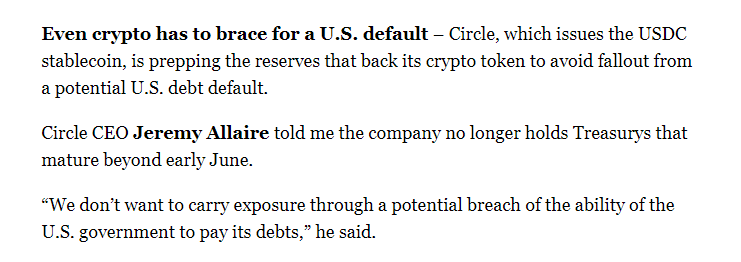- Circle has adjusted its reserve treasury to reduce the risks of U.S. debt defaults.
- Circle has divested Treasuries maturing beyond early June to avoid debt exposure.
- USDC supply has fallen, leading to a decline in market share.
In an effort to mitigate the risks of potential United States debt defaults, stablecoin issuer Circle has reportedly modified its reserves treasury. According to a recent Politico newsletter released on May 10th, Circle CEO Jeremy Allaire disclosed that the company had altered the composition of reserves supporting its USD Coin.
The company changed this by switching to short-dated U.S. Treasuries.
Allaire: No Treasuries Beyond June to Avoid Exposure
Allaire stated that the company no longer holds Treasuries that mature beyond early June to avoid debt exposure, saying, “We don’t want to carry exposure through a potential breach of the ability of the U.S. government to pay its debts.”

As the Blackrock-managed Circle Reserve Fund indicated, its present holdings mature no later than May 31st. In a recent development, Treasury Secretary Janet Yellen revealed that the government may be compelled to make “decisions” if Congress fails to raise the federal debt limit.
President Joe Biden and Republicans are currently at odds over increasing the $31.4 trillion borrowing limit. A default on its debts by the country, which would significantly impact the $24 trillion Treasury market and the global financial system, would follow if an agreement is not reached.
USDC Supply Dwindles: Market Share Down to 23%
Tether, a rival stablecoin issuer, claims that most of its reserves are invested in Treasury bills with an average maturity of fewer than 90 days.
The company stated in a quarterly assurance report released on May 10th that it has been “working to take steps to reduce its reliance on pure bank deposits as a source of liquidity.
Over the past year, USDC supply has dwindled, falling by 46% since its all-time high of $56 billion in June 2022. Consequently, its market share has decreased to 23%, with a circulation of $30 billion. Its competitor Tether, on the other hand, has seen its market dominance rise to 62%, with a circulation of $82 billion USDT.
On the Flipside
- Circle’s move to short-dated U.S. Treasurys may not be enough to mitigate the risks of a potential U.S. debt default, as the action only reduces, rather than eliminates, the risk.
- While Circle has reduced its exposure to U.S. Treasuries, it still holds many of these assets, making up a large portion of its reserves.
- The declining supply of USDC may not necessarily be a negative indicator for the stablecoin, as it could result from increased competition and diversification in the market.
Why You Should Care
The possibility of a U.S. debt default could have significant implications for the crypto market. On the one hand, a default could drive investors towards cryptocurrencies as a hedge against the U.S. dollar.
On the other hand, it could also prompt investors to seek safer assets, decreasing demand for cryptocurrencies. As stablecoin issuers like Circle adjust their reserves to reduce their exposure to U.S. debt, it remains to be seen how the market will react to this potential scenario.
To learn more about how Bitcoin has affected the stablecoin market cap over the last six months, read here:
Stablecoin Market Cap Suffers 6-Month Shrink: How Is Bitcoin Affected?
To learn more about Tether’s successful navigation of recent stablecoin turbulence resulting in a $16 billion market cap rise, read here:
Tether Beats Stablecoin Turbulence with $16B Market Cap Rise
- SEO Powered Content & PR Distribution. Get Amplified Today.
- PlatoAiStream. Web3 Data Intelligence. Knowledge Amplified. Access Here.
- Minting the Future w Adryenn Ashley. Access Here.
- Buy and Sell Shares in PRE-IPO Companies with PREIPO®. Access Here.
- Source: https://dailycoin.com/how-circle-reducing-exposure-to-us-debt-default-risk/
- :has
- :is
- :not
- $UP
- 10th
- 2022
- 31st
- a
- ability
- About
- According
- Action
- Adjusted
- against
- Agreement
- also
- altered
- an
- and
- ARE
- AS
- Assets
- assurance
- At
- average
- avoid
- Bank
- bank deposits
- BE
- been
- Beyond
- Billion
- Bills
- Bitcoin
- Borrowing
- borrowing limit
- breach
- by
- cap
- carry
- ceo
- changed
- Circle
- Circle CEO
- Circle Reserve Fund
- Circulation
- Coin
- comments
- company
- compelled
- competition
- competitor
- Congress
- Consequently
- could
- country
- crypto
- Crypto Market
- cryptocurrencies
- Currently
- Days
- Debt
- Decline
- Declining
- Default
- defaults
- Demand
- deposits
- Development
- diversification
- doing
- Dollar
- Dominance
- Dont
- down
- drive
- Early
- effort
- eliminates
- enough
- Exposure
- external
- fails
- Fallen
- Falling
- Federal
- fewer
- financial
- financial system
- follow
- For
- from
- fund
- Global
- global financial
- global financial system
- Government
- had
- hand
- Have
- hedge
- here
- High
- Holdings
- holds
- How
- HTTPS
- if
- Impact
- implications
- in
- increased
- increasing
- indicated
- Indicator
- internal
- invested
- Investors
- Issuer
- issuers
- IT
- ITS
- Jeremy Allaire
- JOE
- june
- large
- Last
- later
- leading
- LEARN
- like
- LIMIT
- linked
- Liquidity
- longer
- made
- make
- Making
- many
- Market
- Market Cap
- Market Dominance
- mature
- maturity
- max-width
- May..
- Mitigate
- modified
- months
- more
- most
- move
- Navigation
- necessarily
- negative
- Newsletter
- no
- Odds
- of
- on
- ONE
- only
- order
- Other
- over
- past
- Pay
- plato
- Plato Data Intelligence
- PlatoData
- portion
- possibility
- potential
- present
- raise
- rather
- reached
- React
- Read
- recent
- reduce
- Reduced
- reduces
- reducing
- released
- reliance
- remains
- report
- Republicans
- Reserve
- reserves
- result
- resulting
- Revealed
- Rise
- Risk
- risks
- Rival
- s
- safer
- saying
- scenario
- secretary
- Seek
- seen
- Share
- should
- significant
- significantly
- since
- SIX
- Six months
- Source
- stablecoin
- Stablecoin issuer
- stated
- States
- Steps
- Still
- successful
- Suffers
- supply
- Supporting
- system
- Take
- Tether
- than
- that
- The
- their
- These
- this
- Through
- to
- towards
- Treasuries
- treasury
- Trillion
- turbulence
- u.s.
- u.s. dollar
- U.S. government
- U.S. Treasuries
- U.S. Treasurys
- United
- United States
- USD
- USD Coin
- USDC
- USDT
- want
- What
- which
- will
- with
- would
- year
- You
- zephyrnet













